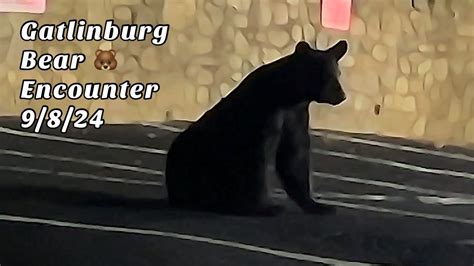
A tourist in Gatlinburg, Tennessee, was caught on video exhibiting dangerous and irresponsible behavior around a black bear, prompting warnings from wildlife officials about the importance of maintaining a safe distance from wild animals. The incident, which occurred recently, serves as a stark reminder of the potential consequences of approaching or interacting with bears, and highlights the need for visitors to adhere to safety guidelines to protect both themselves and the wildlife.
A viral video circulating online shows a woman approaching a black bear in Gatlinburg, seemingly attempting to take a photograph or video at close range. The footage shows the bear initially foraging near a wooded area before becoming aware of the woman’s presence. Instead of retreating, the woman continues to approach, disregarding the bear’s space and potentially provoking a defensive response. The incident concluded without injury, but wildlife experts are using it as an example of what not to do when encountering a bear in its natural habitat. “Don’t Be This Tourist!” urges officials who hope the video will educate visitors.
The Tennessee Wildlife Resources Agency (TWRA) emphasizes that black bears, while often perceived as docile, are powerful wild animals that can become aggressive if they feel threatened or if their food source is compromised. Approaching a bear, especially to take pictures or videos, is a dangerous practice that can lead to serious injury or even death. The TWRA stresses the importance of keeping a safe distance – ideally at least 50 yards – and using binoculars or a zoom lens to observe bears from afar.
This incident underscores a growing concern in areas where human populations overlap with bear habitats. As tourism increases in places like Gatlinburg, the likelihood of encounters between people and bears rises, necessitating increased education and awareness about bear safety. Wildlife officials are actively working to educate visitors about responsible behavior in bear country, providing guidelines on how to avoid attracting bears, what to do if an encounter occurs, and the potential consequences of ignoring these warnings.
The TWRA offers several crucial tips for bear safety, including:
- Never feed bears: Feeding bears, intentionally or unintentionally, habituates them to human food and makes them more likely to approach populated areas. This can lead to property damage and increase the risk of human-bear conflicts.
- Secure food and garbage: Store food in bear-resistant containers or inside a locked vehicle. Dispose of garbage properly in bear-resistant trash cans.
- Make noise while hiking: Announce your presence by talking or singing while hiking in bear country. This gives bears a chance to avoid you.
- Hike in groups: Hiking in groups reduces the risk of a bear encounter and provides safety in numbers.
- Carry bear spray: Bear spray is a non-lethal deterrent that can be effective in stopping a bear attack. Learn how to use it properly and carry it in an easily accessible location.
- Observe from a distance: If you see a bear, observe it from a safe distance. Never approach or attempt to interact with it.
- Back away slowly: If a bear approaches you, back away slowly while facing the bear. Avoid running, as this can trigger a chase response.
- Fight back if attacked: If a bear attacks you, fight back aggressively, using anything you have available as a weapon. Aim for the bear’s face and eyes.
The Gatlinburg incident serves as a cautionary tale about the importance of respecting wildlife and following safety guidelines in bear country. By educating visitors and promoting responsible behavior, wildlife officials hope to minimize human-bear conflicts and ensure the safety of both people and animals. Ignoring these guidelines can have serious consequences, not only for the individual involved but also for the bear, which may ultimately have to be euthanized if it becomes a threat to human safety.
The ramifications of human interaction with wildlife extend beyond immediate safety concerns. When animals become accustomed to human food sources, they can lose their natural foraging abilities and become dependent on humans. This can disrupt their natural behavior patterns and have negative impacts on their overall health and survival. Furthermore, habituated bears are more likely to enter populated areas, increasing the risk of property damage, vehicle collisions, and other conflicts.
The incident has sparked a wider discussion about the role of social media in wildlife encounters. The desire to capture dramatic photos or videos for social media often motivates people to take risks that they would otherwise avoid. Wildlife experts warn against prioritizing social media attention over personal safety and the well-being of animals. They encourage people to appreciate wildlife from a safe distance and to share their experiences responsibly, without encouraging others to engage in dangerous behavior.
Local businesses and tourism operators also have a role to play in promoting bear safety. By providing visitors with information about bear safety guidelines and encouraging responsible behavior, they can help to minimize human-bear conflicts and protect the natural environment. Many businesses in Gatlinburg now include bear safety information in their guest welcome packets and display warning signs in areas where bears are frequently seen.
The long-term solution to minimizing human-bear conflicts lies in a combination of education, responsible behavior, and effective management of bear populations. Wildlife officials are constantly working to monitor bear populations, manage their habitat, and educate the public about bear safety. By working together, residents, visitors, and wildlife professionals can help to ensure that humans and bears can coexist safely in the Smoky Mountains.
This particular incident is not isolated. There have been numerous reports of tourists in the Gatlinburg and Great Smoky Mountains National Park area engaging in risky behaviors around bears, including feeding them, approaching them for photos, and even attempting to touch them. These incidents highlight the need for continued education and enforcement of bear safety guidelines.
Furthermore, the increase in population in areas bordering bear habitats contributes to the rising number of human-bear interactions. As development encroaches on bear habitat, bears are forced to adapt to living in closer proximity to humans, increasing the likelihood of encounters. This underscores the importance of responsible land management practices that protect bear habitat and minimize the potential for human-bear conflicts.
The consequences of ignoring bear safety guidelines can be severe. In some cases, bears that have become habituated to human food or that have attacked humans may have to be euthanized. This is a tragic outcome that can be avoided by following simple safety precautions. By respecting wildlife and maintaining a safe distance, we can help to protect both ourselves and the animals that share our environment.
The authorities remind visitors that feeding any wildlife within the Great Smoky Mountains National Park or any other protected area is illegal and punishable by law. Fines and other penalties can be imposed on individuals who violate these regulations. The enforcement of these regulations is essential to deterring irresponsible behavior and protecting wildlife.
The video of the Gatlinburg tourist serves as a powerful reminder of the importance of respecting wildlife and following safety guidelines. By learning from this example and adopting responsible behavior, we can help to ensure that human-bear encounters remain safe and positive for both people and animals.
The Great Smoky Mountains National Park and surrounding areas are home to a thriving black bear population. These bears are an integral part of the ecosystem and a valuable resource for the region. By working together to protect them, we can ensure that they continue to thrive for generations to come. The incident highlights that awareness campaigns should also focus on different learning styles to ensure the message is well received and remembered. This includes visual aids, interactive sessions, and demonstrations by wildlife professionals to provide clear and effective guidance.
One of the key challenges in managing human-bear conflicts is changing people’s attitudes and behaviors. Many people view bears as cute and cuddly animals, failing to recognize the potential dangers they pose. Overcoming this misconception requires ongoing education and outreach efforts that emphasize the importance of respecting wildlife and maintaining a safe distance.
Another challenge is the increasing pressure on bear habitat due to development and tourism. As more people move to or visit the area, the demand for housing, infrastructure, and recreational facilities increases, putting strain on bear habitat and increasing the likelihood of human-bear encounters. Addressing this challenge requires careful planning and management of land use to minimize the impact on bear populations.
The Gatlinburg incident also raises questions about the effectiveness of current bear safety education programs. While many visitors receive information about bear safety before or during their visit, some may not fully understand or appreciate the importance of following the guidelines. This suggests that there is a need for more engaging and effective education programs that resonate with visitors and motivate them to adopt responsible behavior.
The long-term sustainability of bear populations in the Great Smoky Mountains region depends on a collaborative effort involving residents, visitors, businesses, and wildlife professionals. By working together to promote bear safety, manage bear habitat, and address the root causes of human-bear conflicts, we can ensure that these iconic animals continue to thrive for generations to come.
Frequently Asked Questions (FAQ)
1. What happened in the Gatlinburg bear encounter?
A tourist in Gatlinburg, Tennessee, was filmed approaching a black bear in an apparent attempt to take photos or video at close range. This action prompted warnings from wildlife officials about the dangers of approaching wild animals and the importance of maintaining a safe distance.
2. Why is it dangerous to approach a bear?
Black bears are powerful wild animals that can become aggressive if they feel threatened, protective of their young, or if their food source is compromised. Approaching a bear can provoke a defensive response, leading to serious injury or even death. The Tennessee Wildlife Resources Agency (TWRA) recommends staying at least 50 yards away.
3. What should you do if you encounter a bear in the wild?
If you encounter a bear, remain calm. Observe the bear from a safe distance. Never approach the bear or attempt to feed it. Back away slowly while facing the bear, and avoid running, as this can trigger a chase response. If the bear approaches you, make yourself look as large as possible and make noise. If the bear attacks, fight back aggressively, aiming for the bear’s face and eyes.
4. What are some ways to prevent bear encounters?
To prevent bear encounters, never feed bears, either intentionally or unintentionally. Secure food and garbage in bear-resistant containers or inside a locked vehicle. Make noise while hiking to announce your presence. Hike in groups. Carry bear spray and know how to use it.
5. What are the penalties for feeding bears or violating bear safety regulations?
Feeding bears or violating bear safety regulations within the Great Smoky Mountains National Park and other protected areas is illegal and punishable by law. Fines and other penalties can be imposed on individuals who violate these regulations. Enforcement is key to deterring irresponsible behavior and protecting wildlife.
Expanded Context and Information:
The black bear (Ursus americanus) is a medium-sized bear native to North America. It is the continent’s most common bear species. Black bears are found in a variety of habitats, including forests, mountains, and swamps. In the Southern Appalachian region, including the Great Smoky Mountains, black bears are an integral part of the ecosystem. They play a vital role in seed dispersal and nutrient cycling.
Black bears are omnivores, with their diet varying depending on the season and availability of food. They primarily eat berries, nuts, fruits, insects, and plants. They may also scavenge for carrion or prey on small animals. Bears have an exceptional sense of smell, which they use to locate food sources.
Black bears typically weigh between 200 and 600 pounds, with males being larger than females. They are typically black in color, but their fur can also be brown, cinnamon, or even blond. Black bears have strong claws and teeth, which they use for digging, climbing, and foraging.
Black bears are generally solitary animals, except during mating season or when females are raising their cubs. They are most active during the early morning and late evening hours. During the winter months, black bears enter a state of dormancy, also known as torpor, during which their metabolism slows down and they conserve energy. They do not hibernate in the true sense of the word, as their body temperature does not drop as drastically, and they can be easily aroused.
The black bear population in the Great Smoky Mountains National Park is estimated to be around 1,500. This is one of the highest densities of black bears in the eastern United States. The park provides a large and relatively undisturbed habitat for bears, with abundant food sources and suitable denning sites.
The increase in human-bear interactions in the Gatlinburg area is due to a number of factors, including the growth of tourism, the expansion of residential areas, and the habituation of bears to human food. When bears become accustomed to finding food in populated areas, they lose their natural fear of humans and are more likely to approach homes, businesses, and campgrounds in search of a meal.
The TWRA and the National Park Service are working to manage the black bear population in the Great Smoky Mountains region and minimize human-bear conflicts. Their efforts include educating the public about bear safety, enforcing regulations against feeding bears, and trapping and relocating bears that pose a threat to public safety.
The use of bear-resistant containers is an effective way to prevent bears from accessing food and garbage. These containers are designed to withstand the efforts of bears to open them, preventing them from obtaining a food reward. Bear-resistant containers are available for both residential and commercial use.
Bear spray is a non-lethal deterrent that can be effective in stopping a bear attack. It contains a concentrated form of capsaicin, the active ingredient in chili peppers, which irritates the bear’s eyes, nose, and throat, causing it to retreat. Bear spray should be carried in an easily accessible location and used only as a last resort. It is important to read and understand the instructions before using bear spray.
In some cases, bears that have become habituated to human food or that have attacked humans may have to be euthanized. This is a difficult decision, but it is sometimes necessary to protect public safety. Wildlife officials carefully consider all factors before making the decision to euthanize a bear.
The incident in Gatlinburg highlights the importance of respecting wildlife and following safety guidelines in bear country. By being aware of the risks and taking precautions, we can help to ensure that human-bear encounters remain safe and positive for both people and animals. The rise of social media plays a big role, as tourists and locals may be more inclined to risk their lives for a shareable photo.
The long-term solution to minimizing human-bear conflicts lies in a combination of education, responsible behavior, and effective management of bear populations. By working together, residents, visitors, and wildlife professionals can help to ensure that humans and bears can coexist safely in the Smoky Mountains. This coexistence requires a sustained commitment to conservation, education, and responsible behavior from all stakeholders.
The Great Smoky Mountains National Park and the surrounding areas are home to a diverse array of wildlife, including black bears, deer, elk, and wild turkeys. These animals are an integral part of the ecosystem and a valuable resource for the region. By protecting their habitat and promoting responsible behavior, we can ensure that they continue to thrive for generations to come.
The authorities also stress the need for proactive measures by businesses and local communities. This includes the installation of bear-resistant trash cans and dumpsters in public areas, educating employees about bear safety, and implementing strategies to reduce attractants around commercial properties.
Another important aspect of bear management is habitat conservation. Protecting and restoring bear habitat is essential for maintaining healthy bear populations and minimizing human-bear conflicts. This can involve acquiring land, managing forests, and restoring degraded habitats.
The Gatlinburg incident serves as a valuable lesson for all who live in or visit bear country. By learning from this example and adopting responsible behavior, we can help to protect both ourselves and the animals that share our environment. The incident emphasizes the interconnectedness of human actions and their impact on wildlife populations and ecosystems.
The continued success of bear conservation efforts in the Great Smoky Mountains region depends on the ongoing support and involvement of the public. By staying informed, respecting wildlife, and following safety guidelines, we can all contribute to the well-being of bears and the health of the natural environment.
The incident also underscores the importance of responsible tourism. Tourism can bring economic benefits to local communities, but it can also have negative impacts on wildlife and the environment. By promoting responsible tourism practices, we can minimize these impacts and ensure that tourism is sustainable in the long term.
The need for clear and consistent messaging about bear safety is also crucial. This includes providing information in multiple languages, using visual aids, and tailoring messages to different audiences. The goal is to ensure that everyone who visits or lives in bear country understands the risks and how to avoid them.
The incident is also a call to action for social media platforms to take responsibility for the content that is shared on their platforms. This includes removing content that promotes dangerous behavior around wildlife and providing users with information about responsible wildlife viewing.
The Gatlinburg bear encounter is a reminder that we all have a role to play in protecting wildlife and preserving the natural environment. By working together, we can create a future where humans and animals can coexist safely and sustainably.









